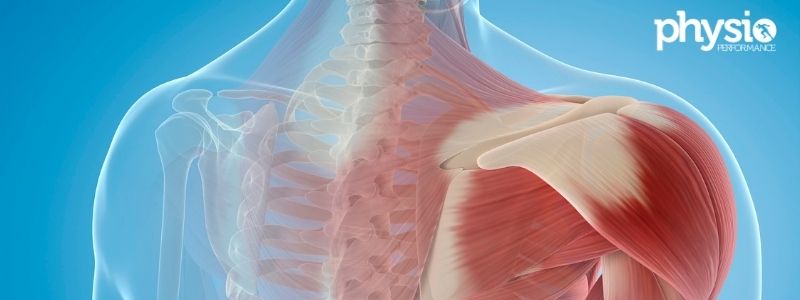Have you been diagnosed with a rotator cuff tear or worried you may have one?
Athletes experience these types of injuries for a number of reasons.
They can result from a tackle, landing on the ground or lifting weights in the gym. Sometimes there has been no specific injury and the tear results from overuse.
We will discuss what the rotator cuff muscles are, the symptoms and our top 5 exercises.
What are the rotator cuff muscles?
The shoulder joint is surrounded by several muscles, and there is one important group of them called the rotator cuff.
The rotator cuff is made up of four muscles; supraspinatus, infraspinatus, teres minor and subscapularis.
They all help to move the shoulder in different directions. But the most important role they have is to stabilise the shoulder joint.
The shoulder is the most unstable joint in the body and it relies on ligaments and the rotator cuff to hold the joint in the correct place, both at rest and during movement.

How do I know I’ve torn my rotator cuff?

The symptoms of a torn rotator cuff include:
- Shoulder pain when reaching your arm out to the side or overhead
- Feeling of weakness in the shoulder
- A grating or clicking noise in the shoulder
- Difficulty sleeping on the affected side
It is possible that these symptoms can also be caused by other shoulder problems such as bursitis and labral tears. It is important to get the correct diagnosis through your Physiotherapist or an MRI scan
How long does it take to recover from a rotator cuff injury?
A recent study found that it can take up to 2 years of conservative management to recover from these injuries. The management included physiotherapy and cortisone injections.
Another study demonstrated that 45% of people with rotator cuff injuries go on to require surgery. This group had pain at rest and struggled to perform everyday activities.
We would advise on starting a rehabilitation programme, and then considering surgery if you were not making any gradual improvements over time.
Top 5 rotator cuff exercises
Here are my top 5 rotator cuff strengthening exercises.
These should be carried out under the direction of a Physiotherapist.
You may need to do other shoulder exercises, before progressing onto these more advanced exercises.
1. Scapular T
Hold a resistance band out in front of you, with elbows straight.
Pull the band backwards to make the letter T with your arms.
You should feel a pinch between your shoulder blades. Slowly return to the start position.
Aim to do 12 repetitions for 3 sets.
2. Scapular Y
This is a progression from the scapular T.
Hold a resistance band out in front of you, with elbows straight.
Pull the band apart and at the same time lift your arms above your head to make the shape of the letter Y.
Slowly return to the start position.
Aim to do 12 repetitions for 3 sets.
3. Shoulder lateral rotation
Tie a resistance band around a stable object like a squat rack or stairs at home.
Stand facing the band and lift your elbow up to shoulder height.
Keep your elbow bent to 90 degrees.
Pull the band backwards by rotating your shoulder, and slowly return to the start position.
Aim to do 12 repetitions for 3 sets
4. Shoulder medial rotation
Tie a resistance band around a stable object like a squat rack or stairs at home.
Stand with your back to the band and lift your elbow up to shoulder height.
Keep your elbow bent to 90 degrees.
Pull the band forwards by rotating your shoulder and slowly return to the start position.
Aim to do 12 repetitions for 3 sets.
5. Bottoms up kettlebell press
This is an advanced exercise and should only be done if the above exercises are not painful.
Start off by holding a kettlebell upside down.
Having to balance the weight forces the rotator cuff to work harder and build more strength.
Press the weight above your head and slowly return to the start position.
Aim to do 8-12 repetitions for 3 sets.
Rotator cuff tears
These injuries require time and patience to overcome.
Symptoms can be managed with rehabilitation.
If gradual improvements are not made over time, surgery may be required to repair the tendon.

